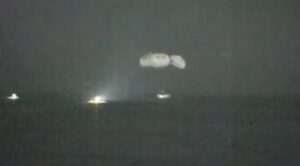Crew Dragon splashes down to end Crew-1 mission
By Jeff Foust

WASHINGTON — A SpaceX Crew Dragon spacecraft splashed down in the Gulf of Mexico May 2, returning four astronauts from a five-and-a-half-month stay on the International Space Station.
The Crew Dragon spacecraft Resilience undocked from the station at 8:35 p.m. Eastern May 1. After departing the vicinity of the station and performing a 16-minute deborbit burn, the spacecraft splashed down in the Gulf of Mexico off the coast from Panama City, Florida, at 2:57 a.m. Eastern May 2. On board the spacecraft were NASA astronauts Mike Hopkins, Victor Glover and Shannon Walker, and Japan Aerospace Exploration Agency astronaut Soichi Noguchi.
The splashdown marked the end of the Crew-1 mission, the first operational commercial crew mission. That mission started with a Nov. 15 launch on a SpaceX Falcon 9, with the spacecraft docking with the station a day later.
The splashdown was the first at night by an American crewed spacecraft since Apollo 8, which splashed down in the Pacific Ocean after its flight around the moon in December 1968. That was the only other U.S. crewed mission to land in the ocean at night.
The decision to splash down at night was driven by the weather conditions. NASA postponed planned splashdowns during the day April 28 and May 1 because of winds and sea states at its landing zones off the Florida coast. However, weather conditions for this landing were ideal, with waves of about 30 centimeters and winds of five kilometers per hour, well within the limits for a safe landing.
“We debated this switch to night very carefully,” Steve Stich, NASA commercial crew program manager, said on NASA TV shortly before the Crew Dragon undocked from the station. “We’re putting the crew and the vehicle down in very benign winds and very benign waves. That’s best for the crew and best for the vehicle.”
Stich said recovery teams got experience with the most recent cargo Dragon mission, CRS-21, which splashed down at night off the Florida coast in January. That spacecraft is similar to the Crew Dragon spacecraft. “We’ve been getting ready for this opportunity,” he said. “When we weighed all those options, it just looked like this was the best time to come home.”
The splashdown marks the end of a busy month on the station that saw two new spacecraft arrive at the station and two depart. The Soyuz MS-18 spacecraft with Roscosmos cosmonauts Oleg Novitsky and Pyotr Dubrov, and NASA astronaut Mark Vande Hei, arrived at the station April 9. The Soyuz MS-17 spacecraft, with Roscosmos’ Sergey Ryzhikov and Sergey Kud-Sverchkov, and NASA’s Kate Rubins, returned to Earth April 17.
Another Crew Dragon spacecraft, Endeavour, launched April 23 on the Crew-2 mission, arriving at the station a day later. It brought to the station NASA astronauts Shane Kimbrough and Megan McArthur, European Space Agency astronaut Thomas Pesquet and JAXA astronaut Akihiko Hoshide. They will remain on the station through late October, when the Crew-3 mission will launch on another Crew Dragon.
May 2, 2021 at 12:45PM
via SpaceNews read more...

Post a Comment